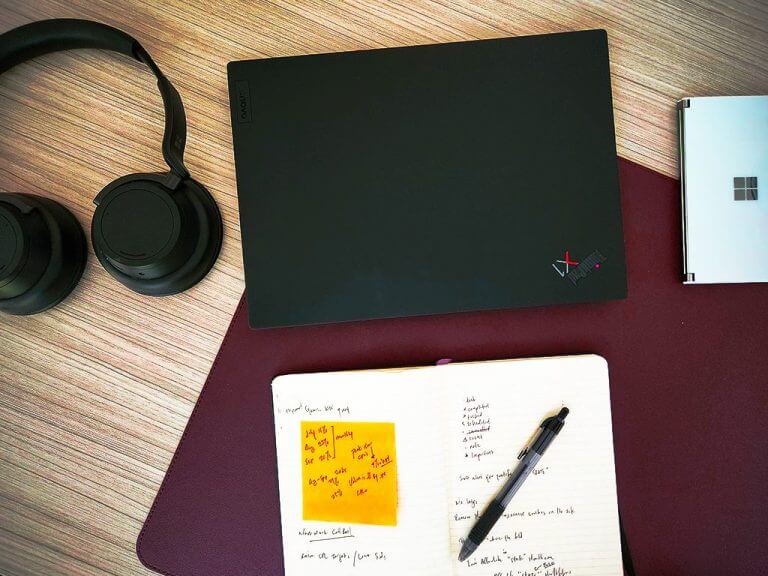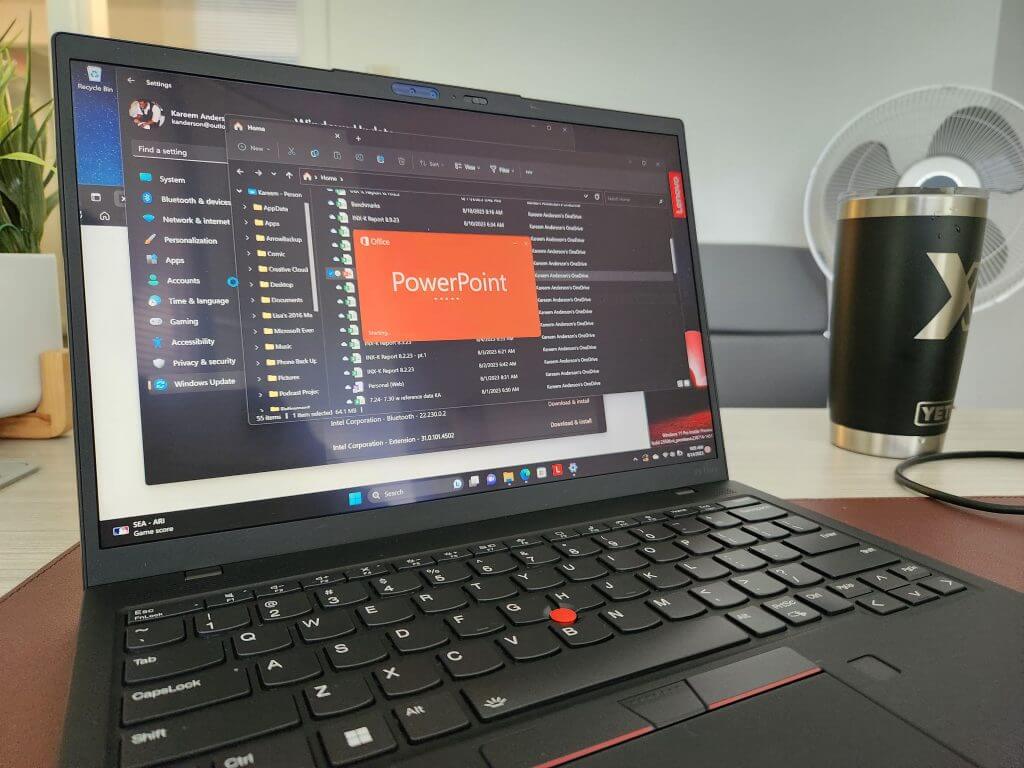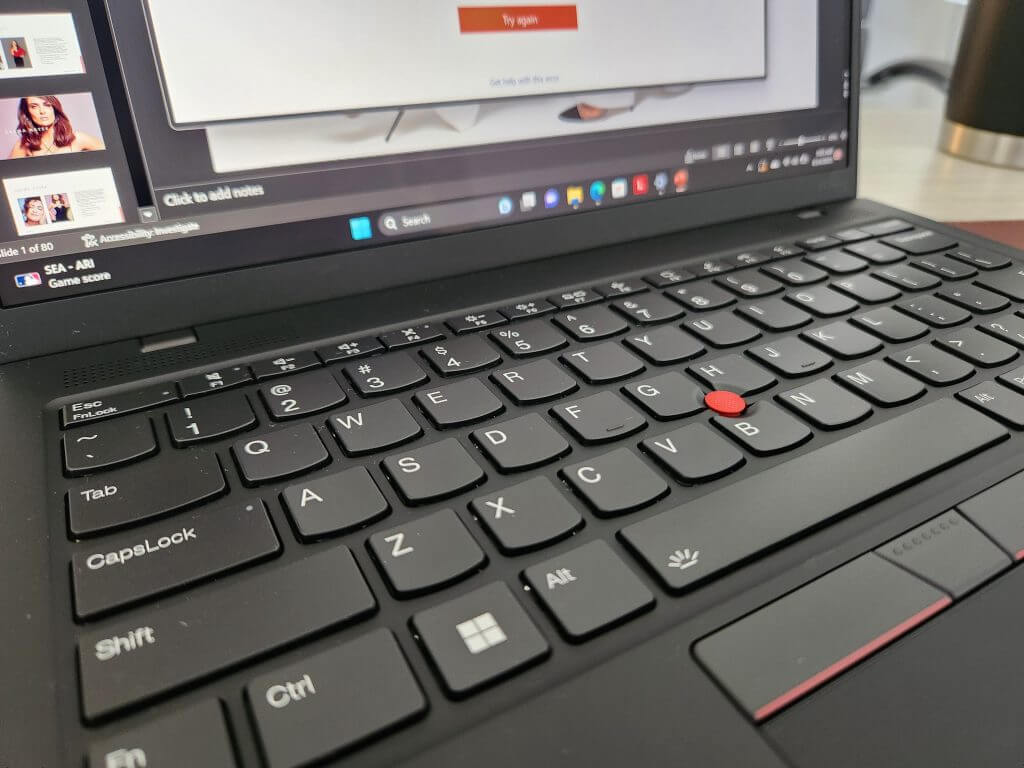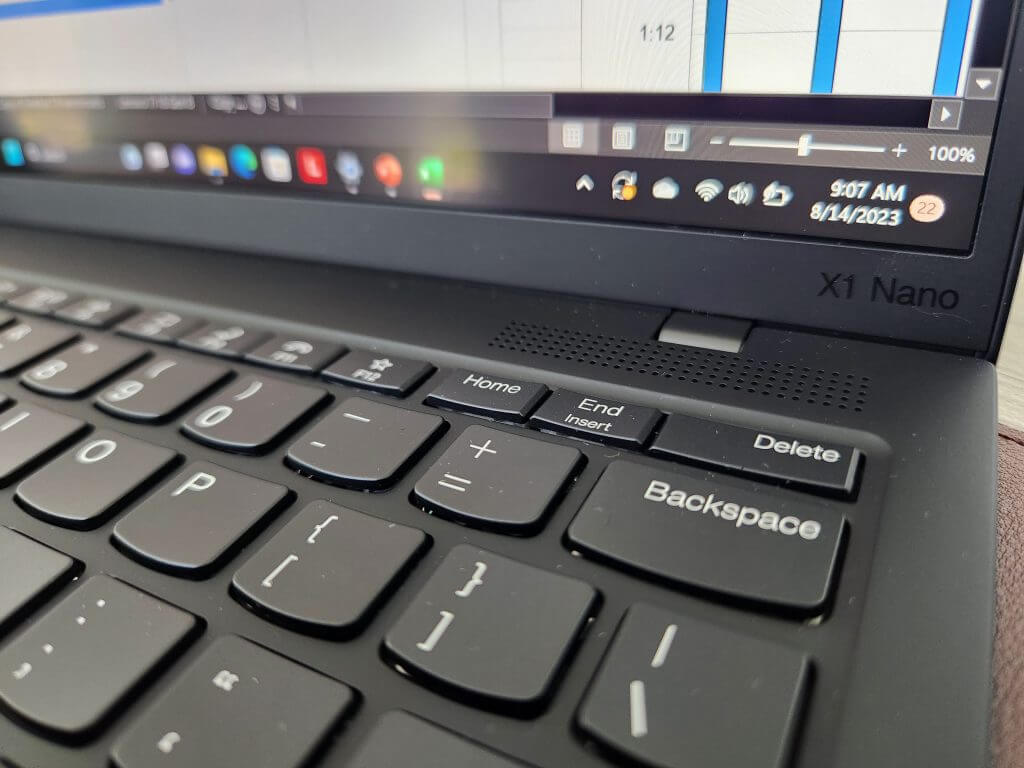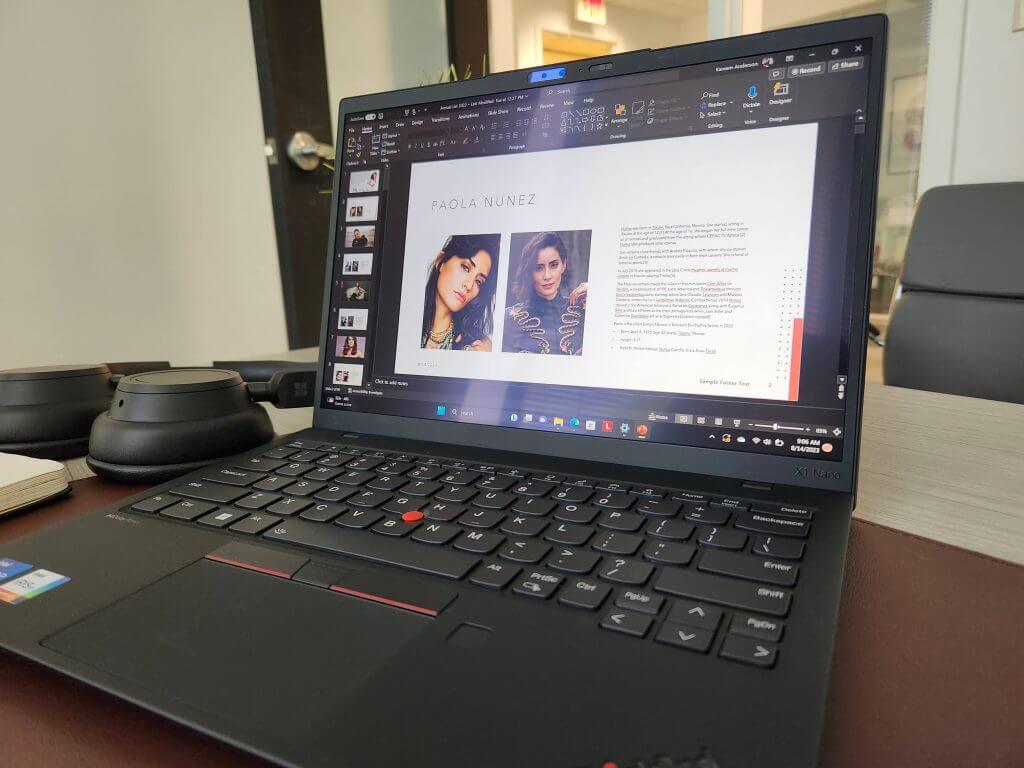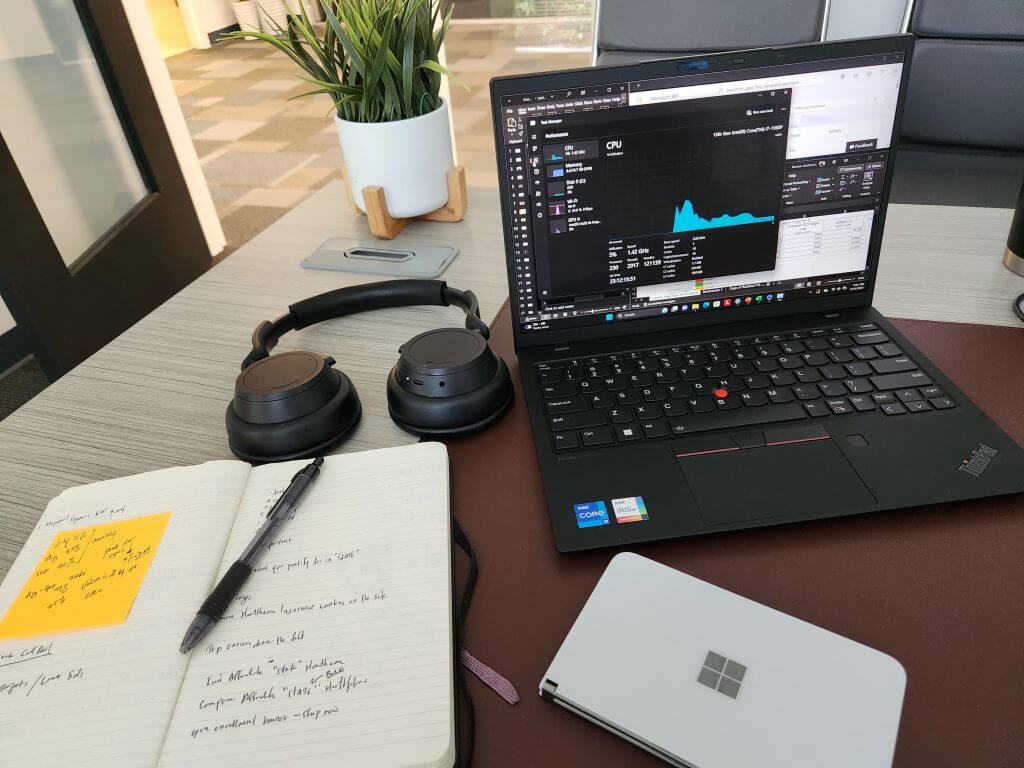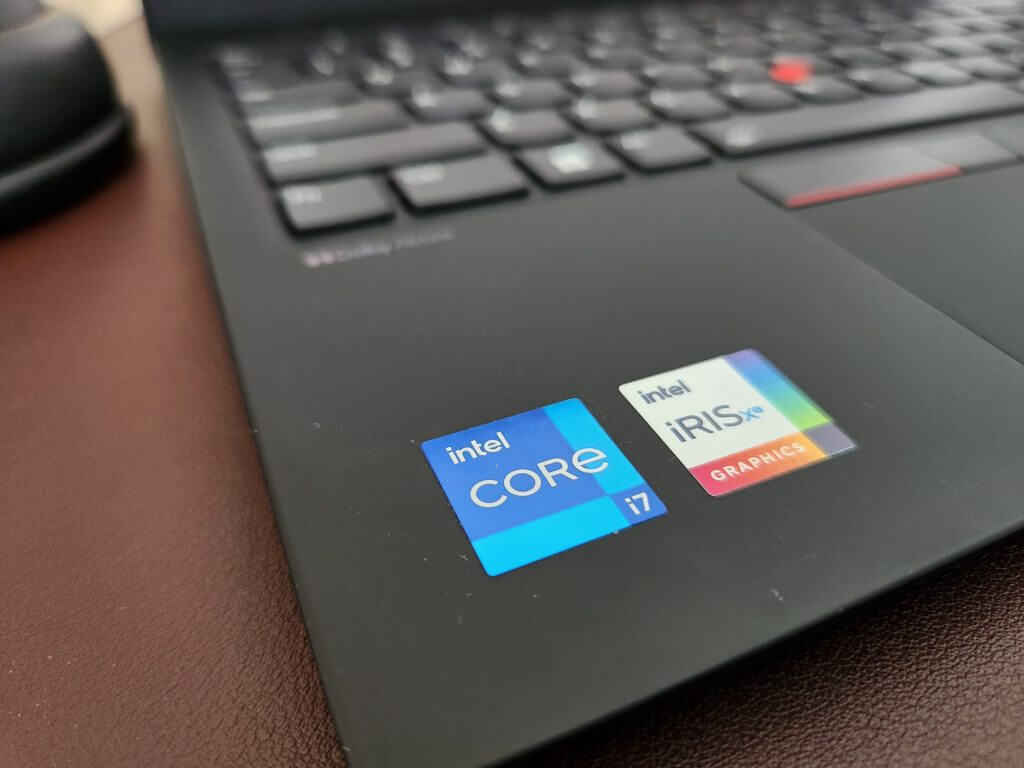Starting at $1,181.00
Lenovo is bringing out a third generation of its ThinkPad X1 Nano, the little brother laptop to the X1 Carbon, and its 2023 release is mixed bag of familiarity and evolutionary performance increases.
SPECS
| ThinkPad X1 Nano 3rd Gen | |
| Processor | 13th Generation Intel® Core™ i5-1340P Processor (E-Core Max 3.40 GHz, P-Core Max 4.60 GHz with Turbo Boost, 12 Cores, 16 Threads, 12 MB Cache)
13th Generation Intel® Core™ i5-1350P Processor with vPro® (E-Core Max 3.50 GHz, P-Core Max 4.70 GHz with Turbo Boost, 12 Cores, 16 Threads, 12 MB Cache) 13th Generation Intel® Core™ i7-1360P Processor (E-Core Max 3.70 GHz, P-Core Max 5.00 GHz with Turbo Boost, 12 Cores, 16 Threads, 18 MB Cache) 13th Generation Intel® Core™ i7-1370P Processor with vPro® (E-Core Max 3.90 GHz, P-Core Max 5.20 GHz with Turbo Boost, 14 Cores, 20 Threads, 24 MB Cache) |
| Operating System | Windows 11 Home |
| Windows 11 Pro – Lenovo recommends Windows 11 Pro for business. | |
| Graphics | Integrated Intel® Iris® Xe graphics |
| Memory | 16 GB LPDDR5X 6400MHz (Soldered) |
| Storage | Up to 1TB PCIe SSD Gen4 |
| Battery | 49.6Whr |
| Supports Rapid Charge (60 minutes = 80% runtime) with 65W or higher power adapter | |
| Audio | Dolby Atmos® |
| Dolby Voice® | |
| 4 x 360-degree quad-array microphones | |
| Camera | FHD (1080p) infrared (IR) Hybrid with webcam privacy shutter |
| FHD (1080p) + IR mobile industry processor interface (MIPI) webcam with Computer Vision & webcam privacy shutter | |
| Connectivity | |
| Ports/Slots | 2 x Thunderbolt™ 4 (1 x always on) |
| Headphone / mic combo | |
| Optional: Nano SIM | |
| * USB port transfer speeds are approximate and depend on many factors, such as processing capability of host/peripheral devices, file attributes, system configuration and operating environments; actual speeds will vary and may be less than expected. | |
| Wireless | WLAN: WiFi 6E* AX211 802.11AX (2 x 2) |
| Optional WWAN: 4G/LTE CAT4 with eSIM** | |
| Bluetooth® 5.1 | |
| vPro®: Only On vPro® processors | |
| * 6GHz WiFi 6E operation is dependent on the support of the operating system, routers/APs/gateways that support WiFi 6E, along with the regional regulatory certifications and spectrum allocation. | |
| ** Optional WWAN availability varies by region and must be configured at time of purchase; it requires a network service provider. Note that not all carriers support eSIM, so please check with your service provider. Not available in China. | |
| Docking | Thunderbolt™ Dock |
| USB-C 3.2 Dock | |
| Design | |
| Display | 13.3″ 2K (2160 x 1350) IPS, anti-glare, anti-reflective, anti-smudge, touchscreen, 450 nits, 100% sRGB
13.3″ 2K (2160 x 1350) IPS, anti-glare, 450 nits, 100% sRGB |
| Dimensions (H x W x D) | Touchscreen: 14.8mm x 293.3mm x 208.1mm / .58″ x 11.54″ x 8.19″ |
| Non-touch: 14.4mm x 293.2mm x 208mm / .56″ x 11.54″ x 8.18″ | |
| Weight | Touchscreen starting at 991.5g / 2.18lbs
Non-touch starting at 966.5g / 2.13lbs |
| Keyboard | Spill resistant |
| Full-size with TrackPoint | |
| Glass TrackPad | |
| Backlit with white LED lighting | |
| Color | Deep Black |
| Sustainability | |
| Material | 90% recycled magnesium on keyboard / bottom sides (C / D covers) |
| 97% post-consumer content (PCC) recycled plastic used in the 49.6Whr battery enclosure | |
| 90% PCC recycled plastic used in 65W adaptor | |
| 30% PCC recycled plastic used in speaker enclosure | |
| Low-temperature solder | |
| Plastic-free packaging with 90% recycled and/or sustainable content | |
| *Packaging composed of recycled, and/or biobased, and/or sustainably forested content. | |
| Certifications / Registries | ENERGY STAR® |
| EPEAT® Gold, where applicable* | |
| Intel® Evo™ | |
| TCO 9 | |
| *Visit www.epeat.net for registration status by country. | |
| Other Information | |
| Security | Discrete Trusted Platform Module (dTPM) 2.0 |
| PrivacyAlert with Glance app | |
| Facial recognition login (requires IR camera) | |
| Fingerprint reader (match-on-chip) | |
| Webcam privacy shutter | |
| Kensington Nano Security Slot™ | |
| Lock on leave with presence detection (requires IR camera) | |
| Computer Vision Human Presence Detection | |
| Preloaded Software | Intel® Connectivity Performance Suite |
| Intel® Unison™ | |
| Lenovo Commercial Vantage | |
| Lenovo View | |
| What’s in the Box | ThinkPad X1 Nano Gen 3 |
| USB-C 65W (supports Rapid Charge) | |
| Internal Battery | |
| Quick Start Guide | |
DESIGN
5/5
There is an aesthetic that the X1 lineup that has been championed by enterprise executives over the past few years and the third gen X1 Nano follows that familiar roadmap, down to the rubberized nano coating on the lid.
Side by side, the Nano Gen 2 and the Nano Gen 3 look practically identical to the original Nano laptop offered by Lenovo back in 2019.
The chassis of the Nano Gen 3 doesn’t deviate far from its predecessor, offering the same limited port selection, weight, and in-hand feel from last year’s release. Customers will be greeted with the same two Thunderbolt 4 ports, a headphone and mic combo and optional Nano Sim tray aligned on the left and right sides of the device.
The fan and ventilation arrangement appears to be the same as last year’s which consist of a bottom facing and right side-aligned exhaust profile make up which becomes a headscratcher when factoring in the SoC selected to power this third generation Nano offering.
Anyone familiar with a ThinkPad keyboard will feel right at home with the same U-shaped chicklet-key design as has been the case for the past decade. For first time customers, the key layout on the 13.5-inch deck is spacious which helps curb the number of accidental keystrokes even for the fastest and or sloppiest typists. Key travel remains springy and responsive at 1.5mm.
The 3rd gen Nano comes with the same bio-authentication features as last year which include the standard Windows Discrete Trusted Platform Module (dTPM) 2.0, IR cameras for Windows Hello facial recognition, a dedicated fingerprint reader that does match-on-chip authentication, a webcam privacy shutter for more discrete users, a Kensington Nano Security Slot for the traveling professional and Lenovo’s Computer Vision Human Presence Detection.
The 1080p FHD camera that does triple duty as a conference webcam, infrared reader and presence detector offers the same stilted image as its predecessors, which is fine in a pinch, but most customers may want to invest in a dedicated lens for better quality videos in the future.
Lastly, the ThinkPad X1 Gen 3 Nano comes in one color, the iconic matte black usually associated with most Lenovo-based enterprise laptops.
The Gen 3 Nano is billed as smaller version of its Carbon cousin and in doing so, it does come in at a svelte 2.18lbs for the touchscreen option and 2.13lbs for a non-touch variant. Nano’s have always been lighter computers and this third generation falls right in line with its predecessors which makes it an ideal companion device to any professional that pulls and packs a laptop more often than the normal cubical warrior.
DISPLAY
3/5
Being a ThinkPad, customers are mostly prone to expect a decent matte display and this third generation Nano does not disappoint, it offers a very adequate display for dealing with typical productivity tasks.
Unlike other laptops in this category, the ThinkPad X1 Nano Gen 3 plays its pretty safe and sticks with a nice 13.3-inch (2160 x 1350) 2K resolution IPS panel that’s equipped with anti-glare, anti-smudge, and anti-reflective coatings.
While the display is easily visible in florescent or warmer home lights, it does top out at 400 nits which means working on the train, a plane with a window open, at a coffee shop with natural light, or on a boat on a sunny day could pose a bit of a problem.
Digging into the technicalities of the display, Lenovo changed the naming scheme of the display from last year, but seemed to keep response times, sRGB coverage, AdobeRGB coverage and color calibration identical to the previous model.
Rather than compare the screen to last year’s model, I took out some old notes from other devices I’ve reviewed this year and the 3rd Gen Nano rates about middle of the pack for IPS panels in this prosumer business category.
At the end of the day, content creators, artists, graphic designers, animators and colorists should look for another device other than the Nano 3rd Gen, this display seems fine-tuned for dealing with data processing, and web-based tasks such as scrolling through Excel files, Word of Doc pages, shifting through endless tabs in Chrome or Edge and catching up on the occasional streaming show while traveling.
Performance
3/5
I mentioned earlier that the chassis and ventilation profile of the Nano 3rd Gen looks and feels identical to last year’s offering and just like last year Lenovo has chosen to go with a P Series SoC instead of the more reasonable U Series most other subnotebooks option.
Last year, the Nano Gen 2 came equipped with a 12th Gen Core i7-1280 and this year customers are greeted with a 13th Gen Core i7-1360P. While the bump in performance is a nice addition at times, Intel’s P Series chips often hit thermal throttling much sooner than the U Series and without improving the chassis or venting on this third Gen device, customers will notice degraded performance even from last year’s laptop.
For benchmark warriors, I’ll add the testing metrics below, but for the layman, the Nano 3rd Gen can outperform devices such as a similarly spec’d Dell Latitude 9330 or even an Apple MacBook Air M2 for CPU dependent tasks for burst tasks but could drop behind others such last year’s Nano Gen 2 or an Asus Zenbook S 13.
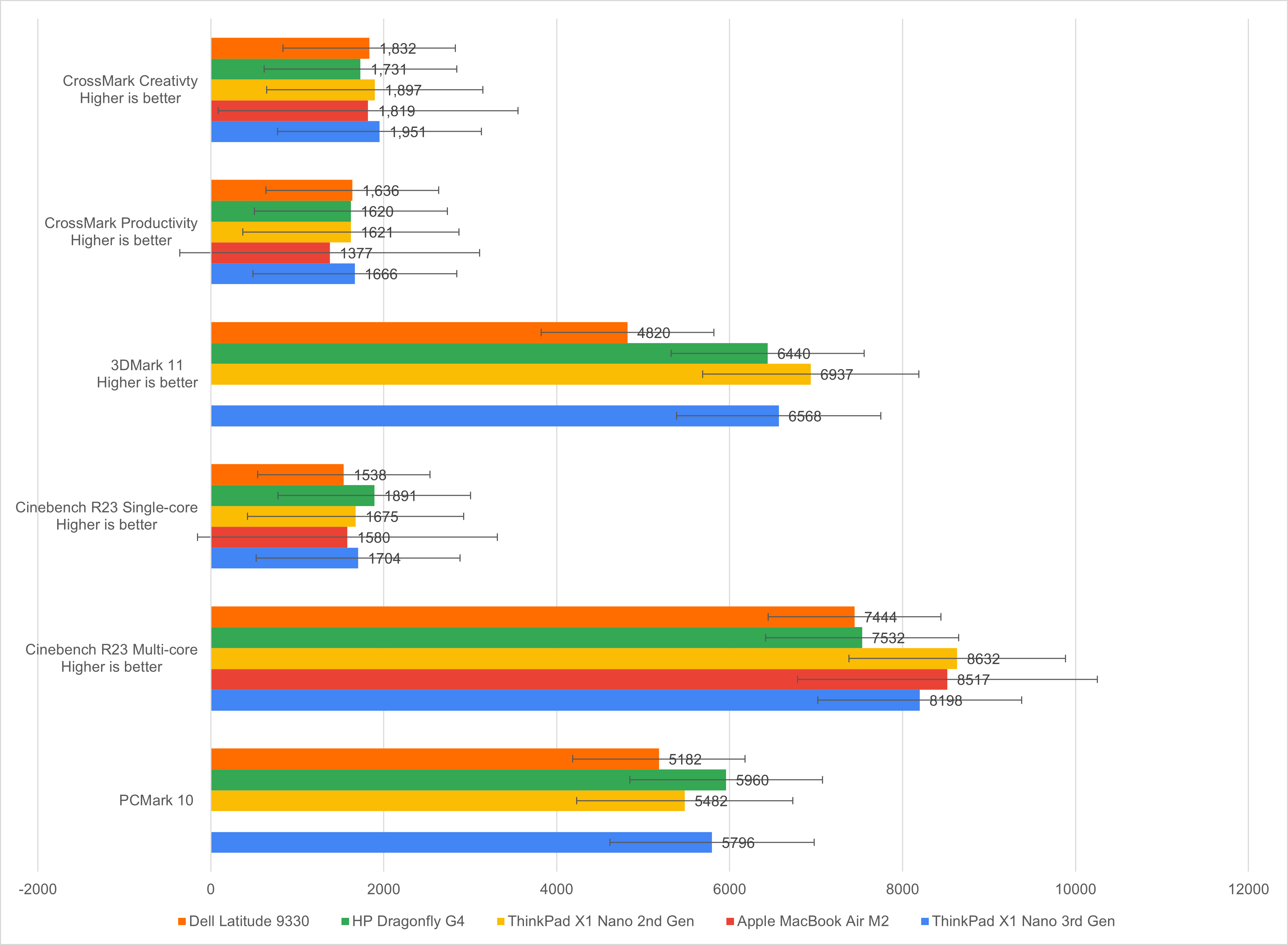
Battery
4/5 (After updates)
Out of the box, battery life could be rated as a 2.5 out of 5 with the Nano 3rd Gen coming up shorter than the Nano Gen 2 performance. While it wasn’t by much, a 30-to-45-minute dip in overall battery life from generation to generation is something that took me by surprise.
The battery capacity of the Nano Gen 3 is roughly the same as its predecessor, so I was ready to chalk up the difference to Intel’s hungry 13th Gen processors that tend to dissipate more heat which leads to longer throttling sessions and degradation in battery performance, until I ran some updates.
After a series of Lenovo BIOS and Windows 11 optimization updates, the Nano Gen 3 began to perform at levels similar to or exceeding last year’s Nano Gen 2, tallying up around 8 hours normal usage.
Using the device full time on WiFi gives the Nano 3 a 35 percent improvement in battery life over the Nano Gen 2 at 480 minutes to 365 while the MacBook Air M2 still holds the benchmark at 808 minutes.
THE MARKETING PROMISE
3/5
Lenovo markets the ThinkPad X1 Nano Gen 3 as “Ultralight. Ultrapowerful. Ultrapossibilities,” and while it absolutely nails its first claim the next two come with caveats that buyers should know about.
The Nano Gen 3 is a very light and portable device that offers some power and some possibilities over other similar subnotebooks in its price range, but with a power-hungry P Series chip, aging ventilation setup and Intel’s slow development in integrated GPUs, this device is limited in what it can offer.
Lenovo seemed to be hyper-focused on making this a professionally portable laptop that’s to be used for data processing on the go, any deviation from this specific niche and the device starts to fray at the edges. Not to say it can’t handle other computing errands, but customers will need to develop their own learning curve on a per-tasks basis.
Summary
The ThinkPad X1 Nano Gen 3 is another excellent standard bearer for the X1 lineup, it last longer than its predecessor, it can outperform last year’s model and it does so while maintaining its signature lightweight design.
However, other manufacturers have caught up to the sleek design of the X1 lineup while offering highlights in other features such as screen tech, battery life and GPU performance.
I view the Nano Gen 3 as the C-suite executive laptop that’s light enough to get lost in a messenger bag and unencumbers users while traveling while still able to hold a video conference, build out P&L reports, crunch data, process marketing non-graphical marketing material, and triage email while simultaneously flying through reference material via the web.
If any of that made sense to you, then this is the laptop for you.

